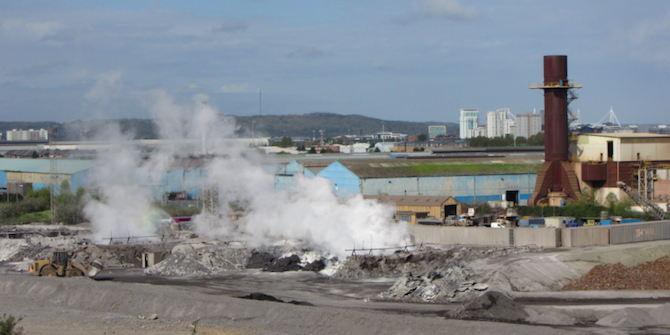 What factors should policymakers take into account when designing an industrial development strategy? Andrew Crawley warns that picking ‘sexy’ sectors such as creative industries and biotech could lead to missed opportunities. Based on his study on Cardiff Capital Region, he advises to play to local strengths and sets out a three-step strategy of criteria to address when identifying the best sectors to foster.
What factors should policymakers take into account when designing an industrial development strategy? Andrew Crawley warns that picking ‘sexy’ sectors such as creative industries and biotech could lead to missed opportunities. Based on his study on Cardiff Capital Region, he advises to play to local strengths and sets out a three-step strategy of criteria to address when identifying the best sectors to foster.
Biotech, Optical Electronics, Creative industries, Advanced Manufacturing: these are some of the perceived ‘sexy sectors’, the industries all regions want to be synonymous with. But is this a realistic pursuit – can regions simply make a list of industries they want, and use this to form meaningful industrial policy? Most people would acknowledge this sounds like an odd approach to regional development, and yet this has been common practice for much of the last two decades.
Since the early 1990s, the then Welsh Development Agency sought to concentrate their industrial support in a number of core industries. This approach was followed through by the English Regional Development Agencies during the late 1990s early 2000s. This preoccupation in encouraging specific types of industrial activity has often resulted in ignoring the relative strengths in a specific region.
 Industry in Cardiff Bay. Credits: Gareth James (CC BY 2.0)
Industry in Cardiff Bay. Credits: Gareth James (CC BY 2.0)
With the abolition of the Regional Development Agencies (RDAs), city regions have fast become the spatial focus for economic development. The goal of city regions is to be more responsive, more in touch with the needs of local stakeholders. However, in developing their industrial policies, city regions appear to be continuing to follow the priorities chosen by the RDAs. One of the considerable criticisms of a ‘picking winners’ approach has been the lack of economic analysis in showing precisely why such industries and the commodities and services that they produce are likely to promote growth in the specific region.
Few people argue with the productivity gains that can be made from the specialization of an industry, but choosing these industries (done either by regions or government) has often been based on what is typically anecdotal and recycled evidence often from noteworthy historically successful regions such as Silicon Valley. It could be argued that using such an approach means that all regions will end up choosing the same sectors regardless of any endogenous capacity they might possess.
For these reasons there needs to be a more coherent and robust identification method for choosing these sectors. To begin with, it can be argued that the most important element when choosing sectors is location-specific characteristics, i.e. things that are inherently local to that industry. I propose three criteria that policymakers should use when identifying sectors: Employment, Interconnectedness, and Comparative Advantage.
1. Employment – It sounds simple, but often policymakers work in terms of potential jobs fixating on fast-growing sectors that have in other areas generated considerable employment. City regions should examine what industries have the highest relative strength of employment in different sectors compared to national averages. This approach means sectors that are truly represented in a city region will rise to the surface.
2. Interconnectedness – The decision should be underpinned by consideration of how interconnected these industries are with the local economy. Different regional industries rely to a greater or lesser extent on local, regional, national and international markets. Each industry also uses labour inputs, and imports goods and services. By comparing between industries in terms of their pattern of resource use, and the sectoral and geographical destinations of their outputs, it allows a greater understanding of the knock-on multiplier effects.
3. Comparative Advantage – It is furthermore crucial to identify industries in the city region that could have a comparative advantage. A simple measure of revealed comparative advantage might be based on the City Region’s defined industry exports compared to its industry imports. This is to say which industries have the economic capacity to compete internationally as well as locally.
By using these three criteria in a multi-stage identification process, city regions stand a much better chance of leveraging the economic benefits from these sectors. I would make a plea to all policymakers to take care in identifying priority sectors in the first place, but when doing so to use due diligence to allow proper identification of the most economically advantageous. It is very tempting to pick the sexy sector; biotech, optical electronics, advanced manufacturing but this can lead to missed opportunities whereby city regions overlook potential success on their doorstep. At least by following the steps outlined here, policymakers have the ability to make decisions based on more robust empirical evidence.
______
Note: This post summarizes the findings contained in the journal article ‘Priority sectors in city regions? Some issues from a study of the Cardiff Capital Region’ (Local Economy, September 2017)
 Andrew Crawley is Assistant Professor at the School of Economics, University of Maine.
Andrew Crawley is Assistant Professor at the School of Economics, University of Maine.
All articles posted on this blog give the views of the author(s), and not the position of LSE British Politics and Policy, nor of the London School of Economics and Political Science.







